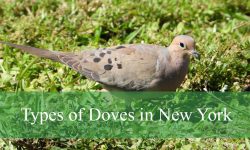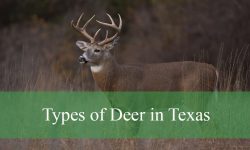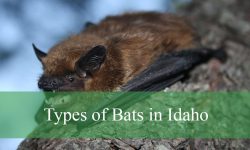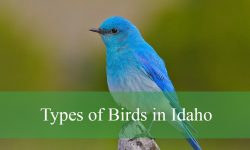Various species of birds exhibit a fascinating array of colors in their beaks, and red is a distinctive hue that captures attention. Among the diverse types of birds with red beaks, one can find a spectrum of shapes, sizes, and habitats. From the vibrant hues of hummingbirds like the Violet-Crowned Hummingbird to the coastal elegance of Black Skimmers, each species showcases the beauty and uniqueness of red-beaked avian diversity. Whether it’s the migratory patterns of Arctic Terns or the striking contrast of a Red-Crested Pochard, these birds contribute to the vibrant tapestry of the natural world with their vivid and captivating red beaks.
In this article, we have compiled 55 different types of birds with red beaks along with images and ways to identify them for your reference.
Different types of Birds with Red Beaks
Common Shelduck
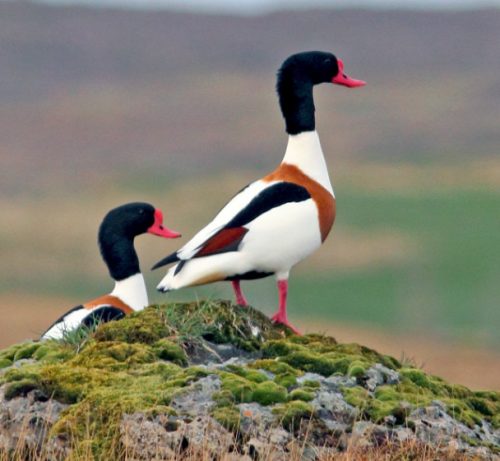
Black heads and contrasting red beaks set the Common Shelduck, technically known as Tadorna tadorna, apart as a species of white, brown, and black ducks. One of the most common migratory species in Asia and Europe, they travel farther in the winter. These shelducks are often found in lakes and mudflats, and they can be distinguished by their loud vocalizations, which sound like a car’s honk. Although Common Shelducks are mainly found in Europe and Asia, they are also occasionally seen in North America, though not frequently enough to make their presence there seem somewhat unusual.
Red Avadavat
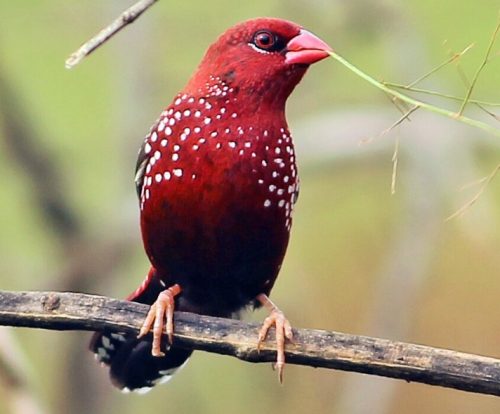
Red beaks are a characteristic of the Red Avadavat, scientifically known as Amandava amandava, albeit the color changes between the sexes. The females have a variegated palette of yellow, grey, red, and black, while the males are mostly red with a few white patches on their wings. The species is known to exist in Europe and Africa, and it has three subspecies that are found throughout Asia, from India to Thailand.
Fischer’s Lovebird
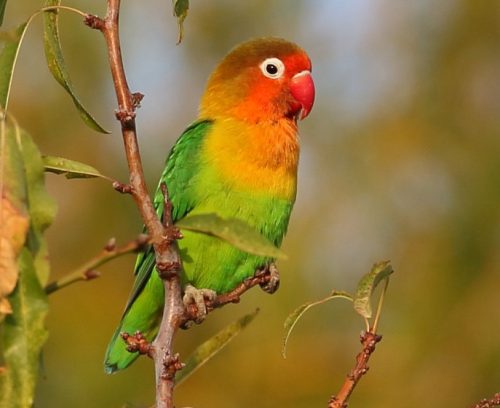
Agapornis fischeri, the scientific name for Fischer’s Lovebird, is a multicolored species that grows to a maximum length of 5.5 inches. This bird, which is native to Central and Eastern Africa, is common in nations like Tanzania and Burundi. It has large concentrations near Lake Victoria. Fischer’s Lovebirds are mostly found in savannahs, where they eat a variety of tiny seeds. Because of their unique requirements for roaming, they are less frequent in captivity than Yellow-Collared Lovebirds. In addition, Fischer’s Lovebirds need a varied daily diet with a wide variety of seeds and fruits in order to flourish, in contrast to other confined species.
Red-Crested Pochard
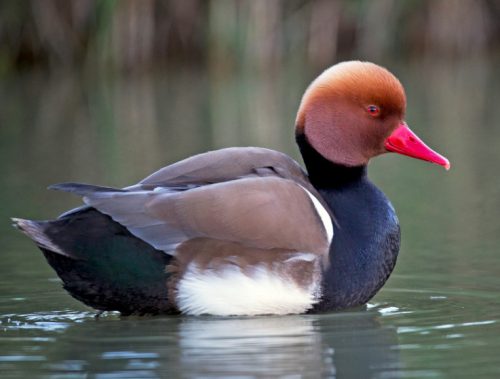
The Red-Crested Pochard, formally known as Netta rufina, is identified by its large red beak, which can grow up to three inches in length. This species has a brown variation with a black and orange beak; the color distinctions are used to distinguish the sexes because only the males have the red beak. During the winter, Red-Crested Pochards migrate southward in search of warmer conditions. During their winter migration, these ducks exhibit gregarious behavior, emphasizing the time when they congregate in bigger numbers, which is an interesting feature of their behavior.
Rosy-Billed Pochard
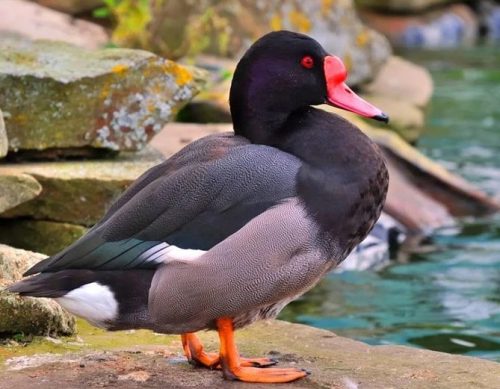
The Rosy-Billed Pochard, formally known as Netta peposaca, gets its name from the males’ distinctively red beaks, which distinguish them from one another. While females have chestnut to brown coloring and gray-black beaks, males have mostly black plumage with gray wings and red beaks. This migratory species lives over a wide range of locations, including isolated islands like the Falkland Islands, from Argentina to Brazil. Although they can eat a wide variety of foods, the majority of their diet is plants, and they have a particular fondness for water weeds, which is a habit these ducks frequently exhibit.
Black-Rumped Waxbill
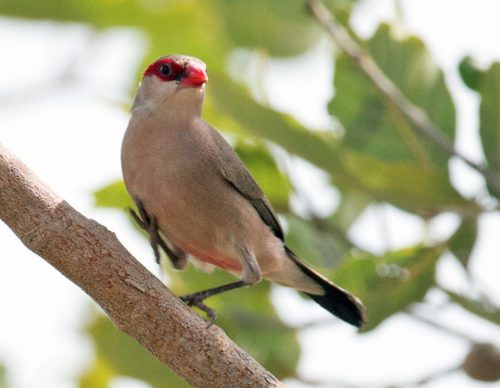
Estrilda troglodytes, the scientific name for the Black-Rumped Waxbill, is a bird that was originally found in southern Africa but has since spread throughout the continent, with reports of sightings in the Middle East. Easily identified by its striking gray, black, and white plumage and red beak, this bird is primarily found in sub-Saharan regions. The reddish-brown crown of the male Black-Rumped Waxbill is an extra remarkable trait that contributes to its unique appearance in its many habitats throughout Africa and the Middle East.
Inca Tern
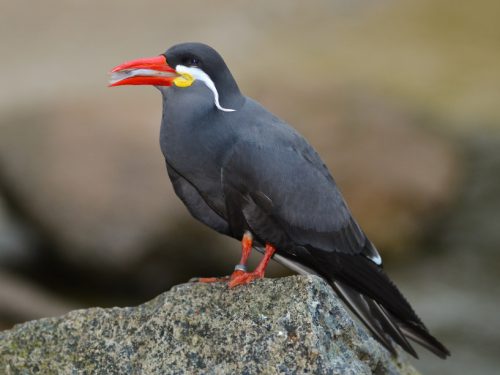
Known by its scientific name Larosterna inca, the Inca Tern is a coastal bird that is regularly seen on South America’s western coast. Originating in South and Central America, it has expanded its range to include the Hawaiian Islands. Inca Terns are primarily gray in color, with contrasting red beaks, red legs, yellow cheeks, and a white lateral band around the head. They resemble doves in shape, color, and size. The species, which primarily eats small fish, has difficulties, such as decreased food supply, which has caused a decline in population in many of its natural habitats.
Common Gallinule
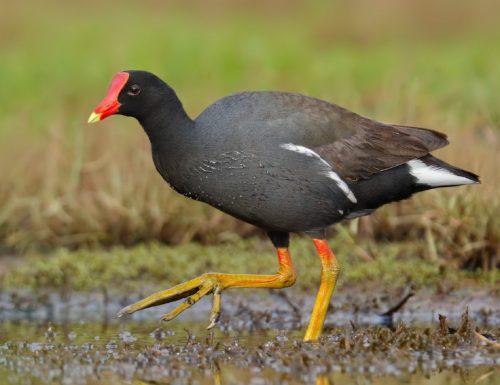
Across North and South America, the Common Gallinule, or scientifically named Gallinula galeata, is one of the most common red-beaked birds. Breeding seasons and migratory patterns have an impact on its range. Rich in Central America and the Eastern/Southeastern United States, it also lives in large parts of South America, although it is not found in tropical rainforests or northern North America. This species, which may grow to a maximum length of 15 inches, is distinguished by its dark blue and black plumage, red beak, and yellow and white legs. It feeds on a variety of small aquatic fish and plants, which helps it adapt to a variety of environments.
Caspian Tern
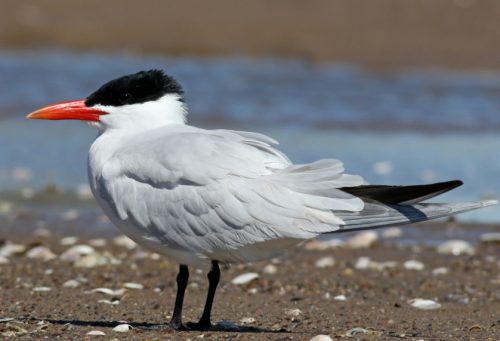
The predominantly white body, black head, and red beak of the Caspian Tern, scientifically known as Hydroprogne caspia, set it apart from other species. Despite frequent long-distance migration, the population of this well-researched species remains stable throughout the world. It has been confirmed to migrate from Asia to North America, primarily near the Great Lakes. It spreads throughout Europe along major waterways such as the Baltic and Black Seas. Caspian Terns are a coastal species that eat fish mostly, demonstrating their tolerance to a wide range of aquatic settings.
Laughing Gull
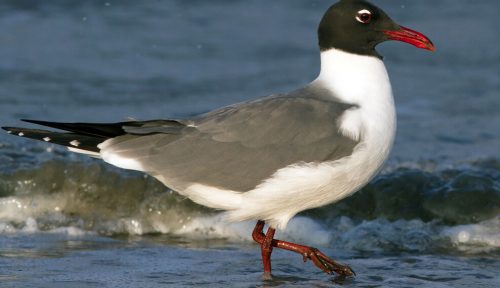
The Laughing Gull, scientifically designated as Leucophaeus atricilla, is distinguished by its predominantly white and black plumage, which is accentuated by a red beak. Its maximum size is 16 inches. Some females may have broad patches of gray on their wings. Age may have an impact on Laughing Gull coloration, as some birds darken with age.
White Ibis
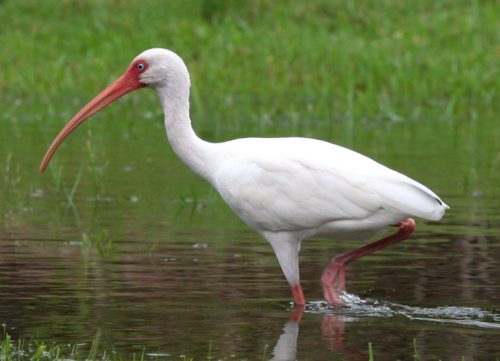
Eudocimus albus, the scientific name for the White Ibis, is distinguished by its red beak and white plumage. This species is frequently found in the southeast US states, especially in the Gulf of Mexico region that stretches from Florida to Texas. During the breeding season, the species congregates in great numbers. The White Ibis is a bird with a strong territorial instinct that has been researched in great detail in North America. It is often observed near water, where it spends over half of the day searching for food. Its diet consists primarily of small fish and crustaceans.
Wood Duck
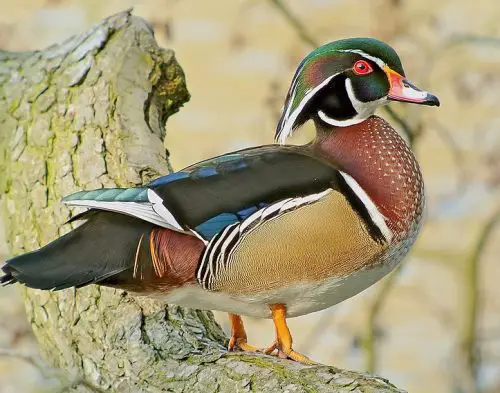
Native to North America, the wood duck, or Aix sponsa as it is formally named, may be found on both the east and west coasts of the country. Males are visually spectacular and contrasted, with pieces of brown, yellow, blue, and white with a red beak; females, on the other hand, have a light brown-gray body with sections of light gray and a brown beak. Wood Ducks are primarily found in swamps and lakes, but they also travel south to spend the winter, demonstrating their versatility in a variety of aquatic environments across their range in North America.
Northern Cardinal
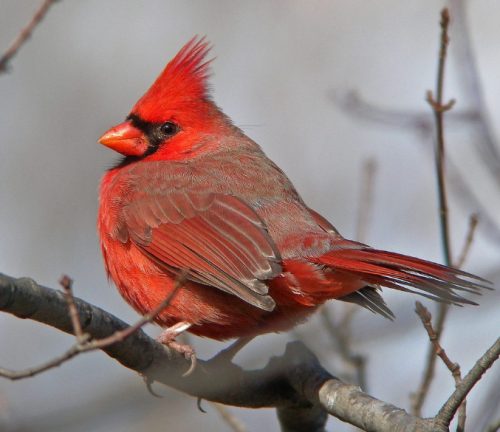
The Northern Cardinal, or Cardinalis cardinalis as it is officially named, is a migratory bird that lives in the Eastern United States. Males are distinguished by their prominent red coloring, which includes a totally red beak and a black facial feature that contrasts with their vivid red plumage. Gray and yellow-brown colors are seen in females, and youngsters share this coloration until they molt to become adults. This species, which may grow to a size of nine inches, lives in populous regions, such as the parks of New York, and feeds on a variety of seeds. The Northern Cardinal, which is frequently seen in North America’s Northeast, livens up metropolitan environments with a pop of color.
Common Merganser
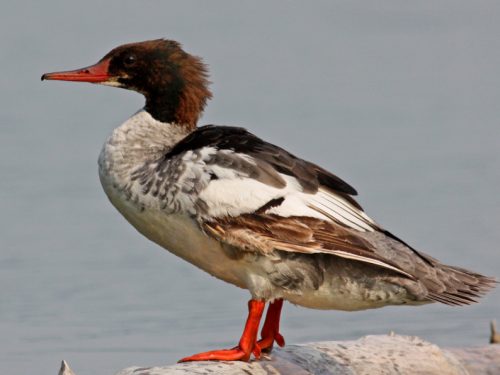
The Common Merganser, or Mergus merganser as it is scientifically termed, is a migratory bird that is found in the Northern Hemisphere. With wingspan of almost thirty inches, males and females are bright reddish-pink in hue. Notable differences may be seen in their red beaks; the males have a bright red color, while the females and young have a deeper red tone. Long crest feathers behind the skull serve as another distinguishing feature of this species. Aquatic settings are enhanced by the bright presence of Common Mergansers, who are well-known for their winter migrations from lakes and rivers.
Black Oystercatcher
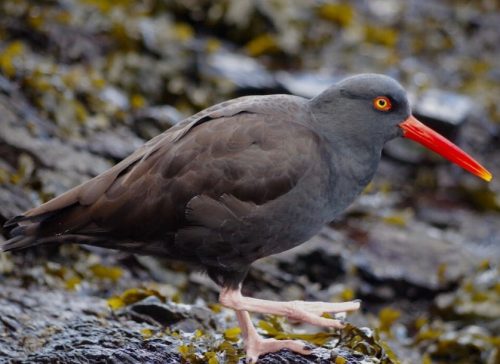
Haematopus bachmani, the scientific name for the Black Oystercatcher, is a migratory bird that only occurs in Western North America and can be found along the West Coast. This species is easily identified by its dark brown feathers and its characteristic red beak, which can take on a pink hue in some areas. People who live closer to Alaska have darker skin tones. The Black Oystercatcher is a coastal bird that prefers to lay her eggs on beaches. It has adapted to its environment and feeds on isopods, mussels, and crabs to survive. There are currently measures in place to safeguard and maintain this uncommon coastal bird, including conservation observation.
Java Sparrow
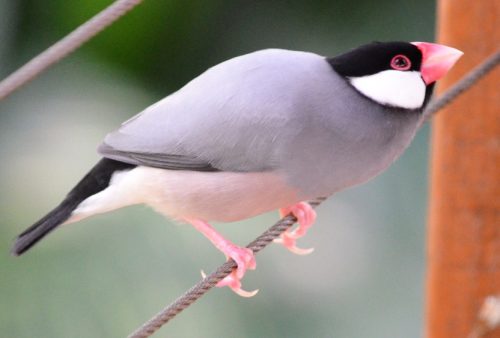
The Java Sparrow, or Padda oryzivora in scientific parlance, is a non-migratory bird that lives in the Indian Ocean region. Its silver-gray color dominates, and its black and white head and mostly red beak are its distinguishing features. This species, which can reach a length of 6.7 inches, gets its name from Java, an Indonesian province. When Java Sparrows reach adulthood, their beaks turn red for both sexes. These birds, which mostly eat seeds and are found in grassland areas, are frequently regarded as pests in the nearby rice fields.
Pin-Tailed Whydah
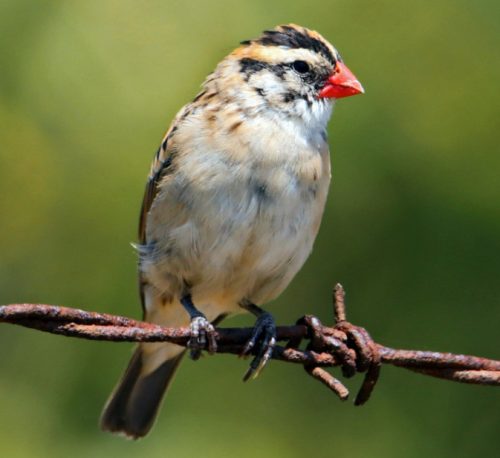
Vidua macroura, the scientific name for the Pin-Tailed Whydah, is a non-migratory bird that can be found in the Southwestern United States, Europe, and Africa. These birds, which are found in large areas south of the Sahara Desert, are easily identified by their very long tails. The Pin-Tailed Whydah, which reaches a maximum length of 5 inches, has a crimson beak on both the male and female. They were introduced to several regions of the world and are well-known for their parasitic ways, frequently depositing their eggs in finch nests. The male exhibits aggressive territorial behavior, highlighting its unique qualities throughout the avian community.
Tufted Puffin
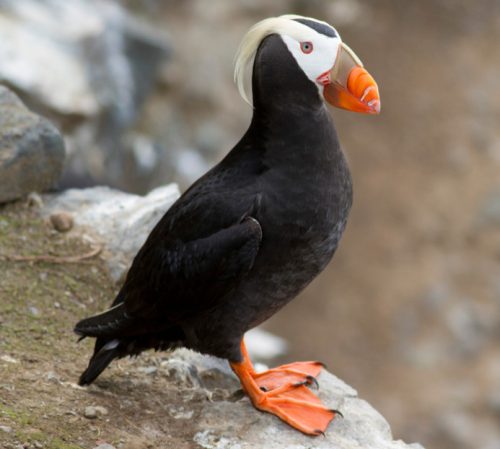
Fratercula cirrhata, the scientific name for the Tufted Puffin, is distinguished by its striking red beak and black feathers. These puffins, which are found in coastal regions of the Northern Pacific territories, may vanish during the winter and seek safety on isolated islands free from predators. They migrate to areas where there are less hazards, which increases their chances of surviving. Throughout its range, the Tufted Puffin relies on fish and tiny crustaceans for sustenance, demonstrating versatility in its coastal habitat.
Yellow-Collared Lovebird
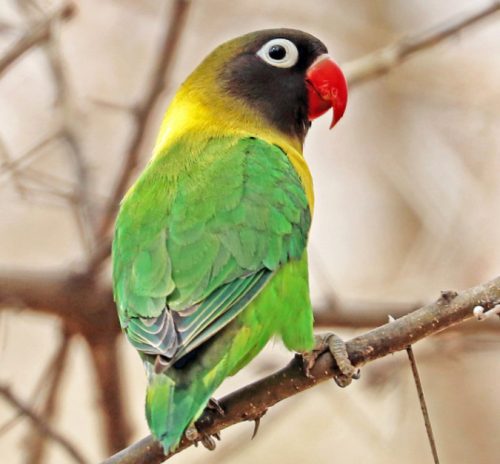
Agapornis personatus, the scientific name for the Yellow-Collared Lovebird, is identified by its black head, yellow and green coloring, and red beak. Numerous color mutations have been verified, including a blue and white variant. Due to its colorful look, this bird is frequently featured in the pet market. However, after escaping from private enclosures, it has established itself in distant Southern US territory. The Yellow-Collared Lovebird’s vibrant plumage adds to its appeal and dispersal outside of its natural home in East Africa.
Gray-Headed Swamphen
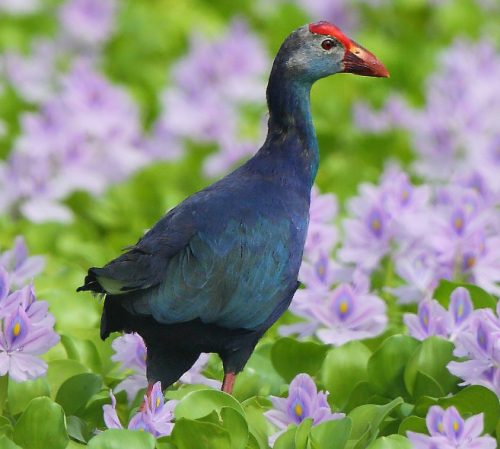
Porphyrio poliocephalus, the scientific name for the Gray-Headed Swamphen, is a non-migratory bird that is native to India. This species is colorful, with males having a black and red beak and females having a red beak. It lives in different marshes in Southeast Asia and India. Both sexes display bright blue feathers. The Gray-Headed Swamphen, which was recently recognized as a separate species, has adapted to live in marshes and among aquatic vegetation. One interesting part of their reproductive rituals is the peculiar way that males impress females during mating by carrying aquatic plants in their beaks.
Common Waxbill
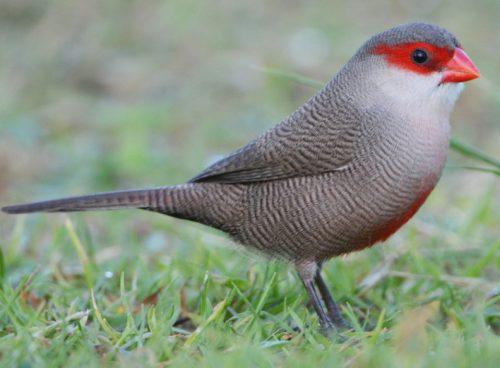
Known by its scientific name, Estrilda astrild, the Common Waxbill is a non-migratory bird that is often found in Africa to the south of the Sahara Desert. This gray bird, which has at least 17 subspecies, is 5 inches tall and has a red or orange beak. Usually submissive, it is often seen in captivity and zoos. The main sources of food for the Common Waxbill are grasses and tiny seeds; its favorite food is crabgrass. Females that thrive in grasslands may also eat small insects to fulfill their nutritional requirements for laying eggs.
Mandarin Duck
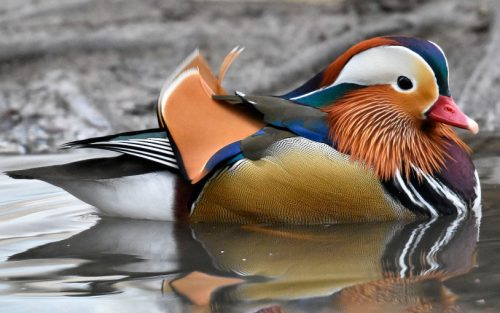
The Mandarin Duck, Aix galericulata in scientific parlance, is a migratory bird that inhabits Asia, North America, and Europe. Usually found in Europe and some regions of North America, these birds migrate over a long distance to Eastern Asia, where they spend the winter in China, Japan, and South Korea. The ladies are gray-colored with some blue and white feathers, while the males are brightly colored, primarily white, and have a red beak. Mandarin Ducks are mostly threatened by raccoons in their natural habitats, despite their varied diet of plants and insects.
Arctic Tern
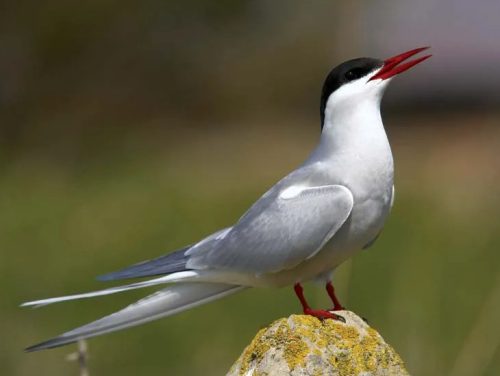
The migratory bird known as the Arctic Tern, or Sterna paradisaea in scientific parlance, gets its name from its Arctic habitat, which includes the Arctic Circle, Northern Europe, Canada, and Alaska. This species, which is distinguished by its red beak and white and gray plumage, sets out on an incredible 4,000-mile journey to the Antarctic for its wintering quarters. Admired as the national bird and a social status symbol in many regions, the Arctic Tern demonstrates fortitude and perseverance during its amazing seasonal migration.
Violet-Crowned Hummingbird
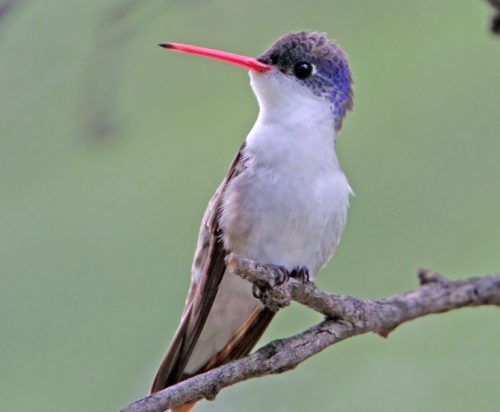
Leucolia violiceps, the official name for the Violet-Crowned Hummingbird, is a migratory species that may be found in Northwestern Mexico and the Southwestern United States. During its migratory journey, this hummingbird travels through the Southern US regions and Southwestern US deserts, making a statement with its violet-to-blue crowns and red or red-and-black beak. It breeds in Mexico and reaches as far north as Arizona, demonstrating its resilience to a variety of habitats throughout its migratory range. It prefers warmer climes.
ʻIʻiwi

The ʻIʻiwi, or Drepanis coccinea as it is scientifically called, is a small species of native Hawaiian bird distinguished by its red beak and overall red appearance. Most remarkably, it migrates vertically, climbing mountains in the direction of flower blooms all season long. Its distinct migration pattern has made it difficult to estimate its population with any degree of accuracy. The ʻIŻiwi introduces itself to possible predators and parasites during frequent low-altitude foraging trips.
Black Swan
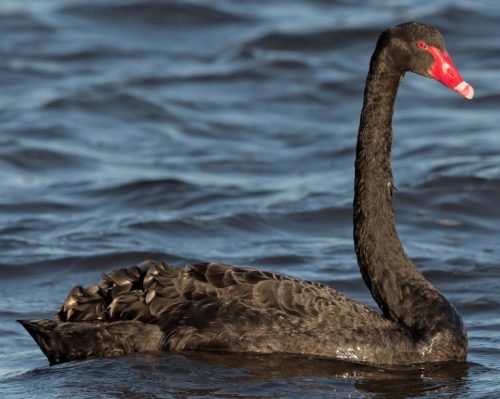
The scientific name for the Black Swan is Cygnus atratus. It is distinguished by its eye-catching black feathers and scarlet beaks with white bands. Adult Black Swans retain their distinctive black color, however juveniles may seem lighter with gray to brown coloration. Originating from the coastal regions of Australia and New Zealand, this species has been spread worldwide for decorative purposes, where it has multiplied in lakes, ponds, and coastal locations.
Red-Billed Leiothrix
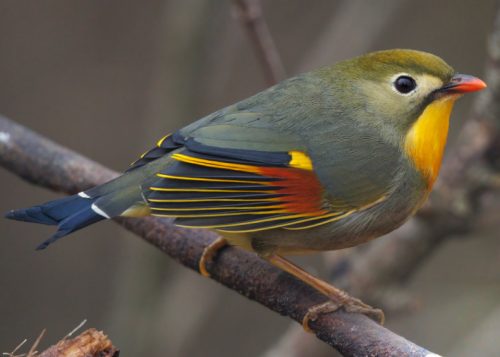
Leiothrix lutea, the scientific name for the Red-Billed Leiothrix, is a bird that stands out for having a bright red beak and striking hues of yellow, green, red, and gray. This species, which may grow up to 5 inches long and is native to East Asia (China, Nepal, etc.), has been brought to Hawaii and other places worldwide. The Red-Billed Leiothrix, which is found in five subspecies worldwide, is able to adapt to its environment and extend beyond it by feeding on a variety of fruits.
Zebra Finch
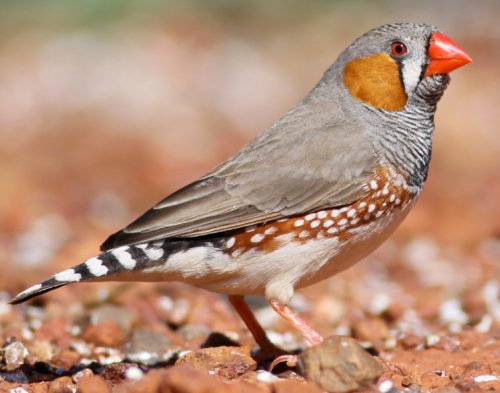
Scientifically known as Taeniopygia guttata, the zebra finch is endemic to Oceania, extending from Australia to Timor. It is distinguished by its scarlet or orange-red beak. The remarkable capacity of the Zebra Finch to learn vocalizations has made it famous and made it a study subject. Direct communication relies heavily on vocalizations, which also affect female mating choices. These finches are gregarious creatures; they frequently migrate and live in flocks, demonstrating their preference for communal living in their natural environments in Oceania.
Red-Breasted Merganser
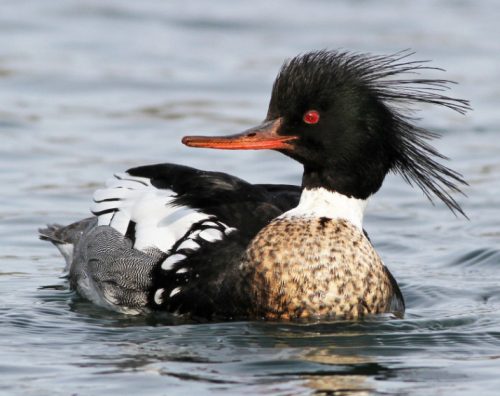
Mergus serrator, the scientific name for the Red-Breasted Merganser, is a common bird found in Europe, Asia, North America, and Greenland in the Northern Hemisphere. It has a characteristic yellow beak. The females have a brighter appearance with an orange or orange-brown beak, while the males have a black head with metallic green undertones and a red beak. One of the world’s swiftest ducks, Red-Breasted Mergansers demonstrate their speed in flight and when catching prey, especially fish, by employing their quick reflexes to maneuver through their aquatic environments.
Black Skimmer
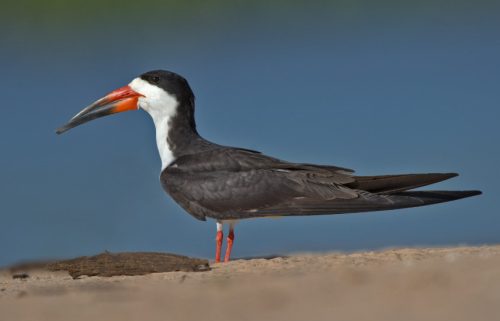
The Black Skimmer, or Rynchops niger as it is named scientifically, has a striking black and white look that is enhanced by a crimson beak. One subspecies migrates, while the other two are non-migratory. These birds have remarkable wingspan of up to 50 inches, with black wings and white underparts. Many migrate from South America to the Southeastern US territory, where some communities from North America choose to spend the winter in the Caribbean. Black Skimmers are gregarious birds that work together to forage. They hover slightly over the water to quickly scoop up small fish and mollusks, such as the Atlantic Killifish, demonstrating their nimble eating technique.
American Purple Gallinule
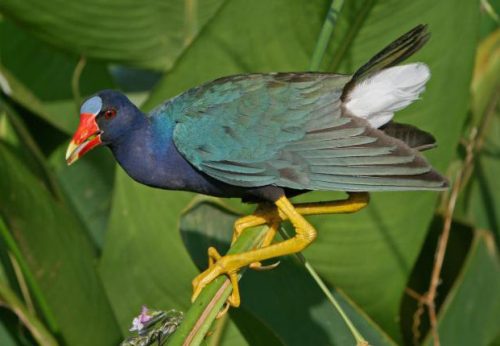
Porphyrio martinica, the scientific name for the migratory American Purple Gallinule, is a bird of green and blue coloration that has a characteristic red and yellow beak. This species, which may reach a height of 15 inches, is sometimes called The Yellow-legged Bird because of its vivid yellow legs. These birds, who live in a variety of aquatic environments, have evolved exceptionally long yellow toes that they utilize to navigate over vegetation. The American Purple Gallinule is mostly found in isolated Southeastern areas in the United States, including the Everglades National Park.
Common Tern
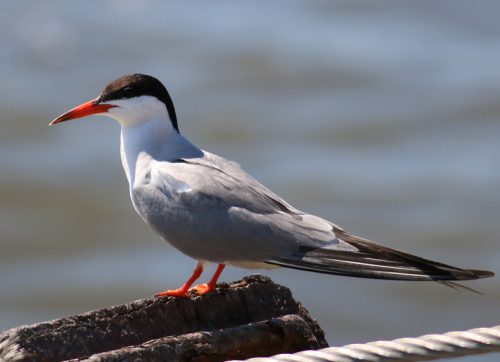
Sterna hirundo, the scientific name for the common tern, has beaks that are red or orange in color, with some subspecies having an orange and black combination. This white bird, which is found throughout the world’s Subarctic regions, frequently has a black head and a gray-white look. These birds’ unique color distinctions are brought about by regional variations. Known to include four subspecies with varying color and length of wingspan, Common Terns migrate southward in large groups throughout the winter, demonstrating their versatility and diversity throughout Europe, North America, and Asia.
Broad-Billed Hummingbird

The Broad-Billed Hummingbird, scientifically known as Cynanthus latirostris, may grow up to 5 inches in length and is easily recognized by its long red beak and metallic green coloring. Males, females, and young birds have distinct color differences, with the latter grouping more like that of females. This species, which is frequently found among agave and honeysuckle, mostly feeds on plant nectar but can also eat insects. The species is well known to migrate, often from the northern regions of US states into Mexico.
Buff-Bellied Hummingbird
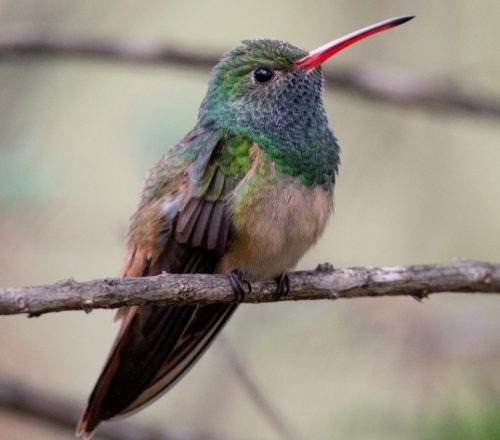
The scientific name for the Buff-Bellied Hummingbird is Amazilia yucatanensis. It has a red beak and a bright metallic green tint. Males and females differ noticeably in color; the female has a less metallic tint and a hint of chestnut on its tail. This hummingbird, which is common along the Gulf of Mexico, mostly eats plant nectar from flowers, bushes, and trees. Its capacity to adapt in both North America and Central America is further demonstrated by the fact that it can augment its diet by eating tiny insects that are located on plant leaves and flowers.
American Oystercatcher
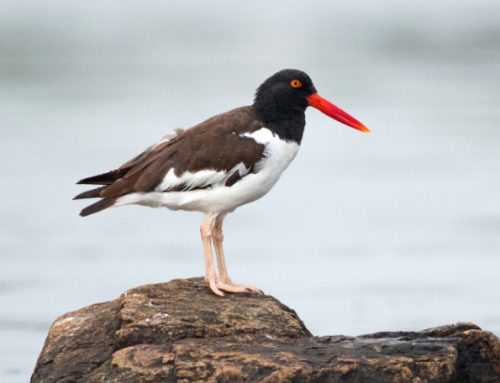
The scientific name for the American Oystercatcher is Haematopus palliatus. Its striking black-and-white look is enhanced by a bright red beak. This species, which is found only in coastal regions of North and South America, is renowned for having a lengthy life span—it can live for several years. By their fourth year, both males and females reach sexual maturity and begin courtship rituals. The intricate mating ritual, in which the male and female stroll along the shore, gives the coastal environments where these birds live a distinctive behavioral element.
Black-Bellied Whistling Duck
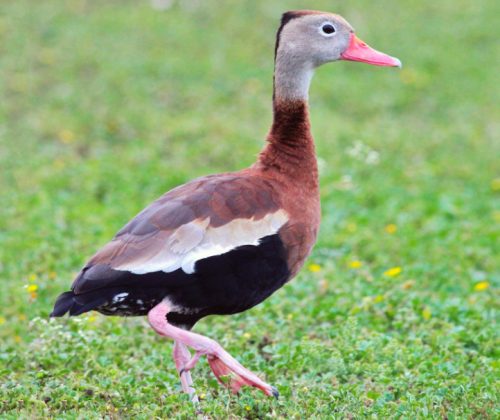
The Dark-Bellied The scientific name for the Whistling Duck is Dendrocygna autumnalis. It has a dark brown body with noticeable black areas around its wings and abdomen. Its characteristic crimson beak is seen on both males and females. This species, which prefers to feed at night, eats a variety of plants and insects. In addition to maize grown on land, aquatic plants like weeds and millet are also eaten. In addition, the ducks regularly eat spiders and water beetles, demonstrating their versatility and variety of eating preferences, particularly at night.
Red-Billed Tropicbird
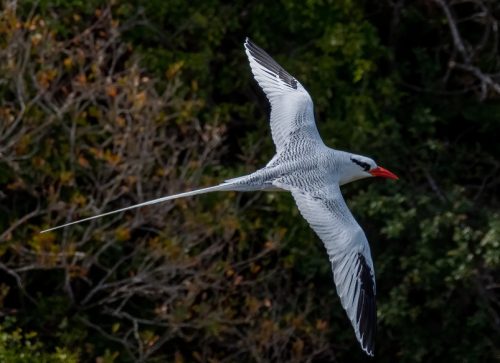
Phaethon aethereus, the scientific name for the Red-Billed Tropicbird, is found in many tropical parts of the world, including the Central Atlantic, Persian Gulf, and East Pacific. This bird, which is distinguished by its red beak in all three subspecies, loves to fly slowly throughout its extended flights, reaching up to 27 miles per hour. It is not good at walking. Because they prefer desolate places and select isolated cliff spots for depositing their eggs to reduce the risk of predation, a significant portion of their life are still unknown.
Red-Billed Chough
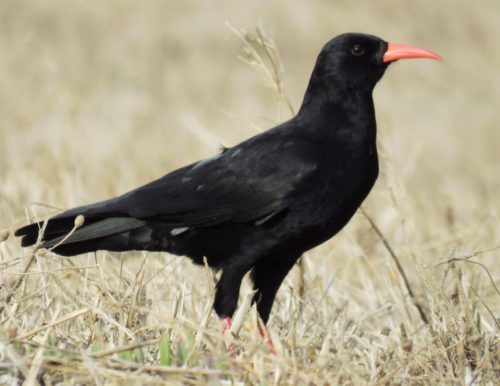
Scientifically known as Pyrrhocorax pyrrhocorax, the Red-Billed Chough is a widely widespread species that can be found in Europe, North America, Asia, and Oceania. Though it is only found in Australia, it is noticeably absent from the Southern Hemisphere. Growing to great altitudes, especially in grasslands and prairies in North America, Europe, and Asia, this plant exhibits an affinity for coastal areas. Within its wide and varied habitat, the Red-Billed Chough is a common predator, its estimated hundreds of thousands of individuals in Europe alone. Its diet consists primarily of flies, spiders, and other insects.
Dollarbird
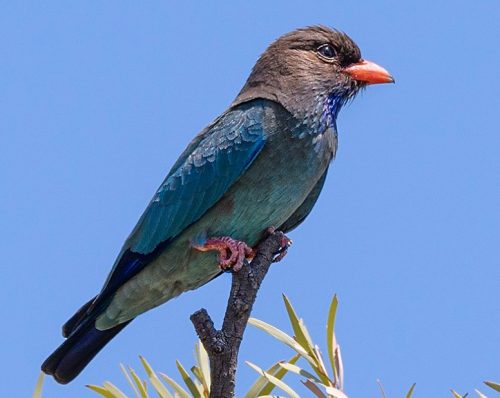
The Eastern Hemisphere is home to the widely distributed Dollarbird, scientifically known as Eurystomus orientalis, which is mostly found in Oceania and Asia. Easily identifiable by its vivid red beak, this bird has a vivid green or emerald-blue coloring that is enhanced by a deeper green head. Known by most as The Dark Roller, it is easily identified by the bright red color of its beak and legs. The Dollarbird is a large bird that may reach a size of 11 inches and is found from Australia to Japan. Its primary food source is insects, and it uses particular techniques, such quick recognition flights, to find its prey.
Coscoroba Swan
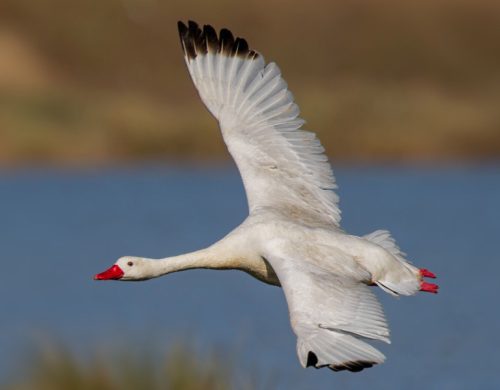
The Coscoroba Swan, or Coscoroba coscoroba as it is officially titled, is a common bird in South America that is well-known for its migratory habits during the breeding season. These swans have a unique migration pattern; after breeding in several Southern South American nations, they migrate north to spend the winter. Their bright red beak creates a dramatic contrast to their otherwise homogeneous white plumage. These swans are well-suited to a variety of environments, and they can be found in low-lying areas as well as at elevations above 4,000 feet. Skillful swimmers, they mostly subsist on small fish species found throughout their South American environments.
Red-Billed Blue-Magpie
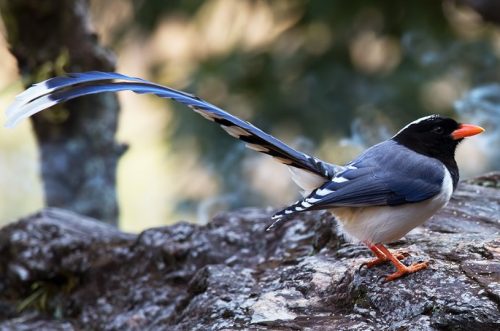
Urocissa erythroryncha, a scientific name for the Red-Billed Blue Magpie, is a unique species of bird found in Southeast Asia. This magpie has a long black tail, short red beak, and legs. Its distinctive black-and-white plumage completes its appearance. It can travel small distances by changing altitude, but it cannot do large long-distance migrations. The bird lives in trees or tall shrubs and eats insects, seeds, grasses, and small invertebrates.
Common Moorhen
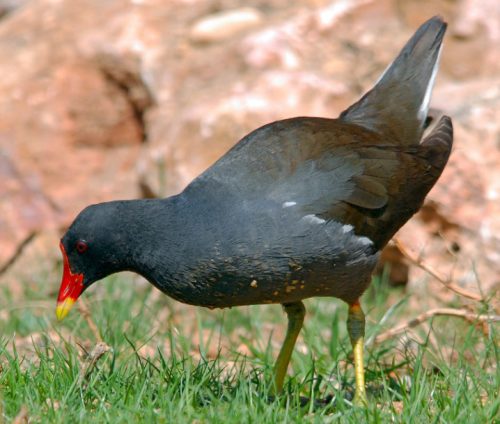
The Common Moorhen, or Gallinula chloropus as it is scientifically named, is distinguished by its red beak and mostly black feathers. These birds are found all throughout the world, from Europe to Africa and Asia. They live in the verdant areas that surround lakes, rivers, and marshes. Some Common Moorhens move to warmer or more temperate places from areas with harsh winters. The male Common Moorhen is particularly aggressive and territorial, especially during the mating season, establishing supremacy over its selected waterways and marshland territory. It shares habitats with other water-loving birds, such as ducks.
Heermann’s Gull
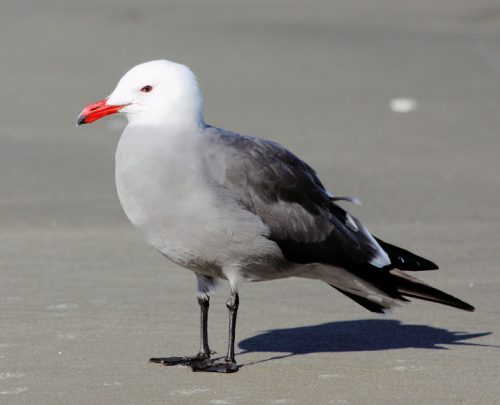
The scientific name for Heermann’s Gulls is Larus heermanni. They are distinguished by their gray-and-white plumage and their red beaks with black ends. These gulls are found in Western North America, mostly around the Gulf of California and further north along the West Coast, where they dwell almost entirely near water. They mostly eat species that are caught close to the coast, such as fish, lizards, and sometimes carrion. Notably, during their breeding seasons, gulls create colonies and lay their eggs, usually on the ground, providing a great chance for observation.
Eurasian Oystercatcher
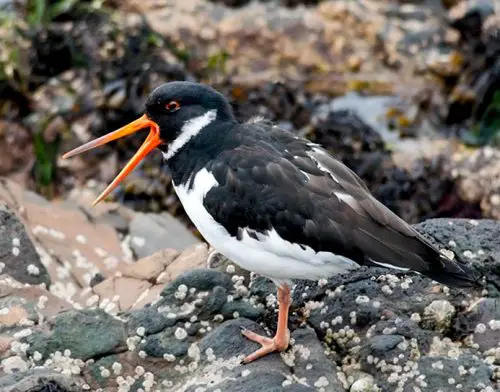
Haematopus ostralegus, the scientific name for the Eurasian Oystercatcher, is found in parts of Asia, Africa, and Europe. People in Northwestern Europe tend to stay put, even though many migrate. The coasts of Northern Africa and Southeast Asia around the Indian Ocean serve as migration corridors. These birds have a characteristic black-and-white appearance that is enhanced by their large crimson beaks. Due to its regular presence and distinctive characteristics, the Eurasian Oystercatcher, which is typically found in coastal areas and on tiny islands, is considered a status symbol in its native territory.
Australasian Swamphen
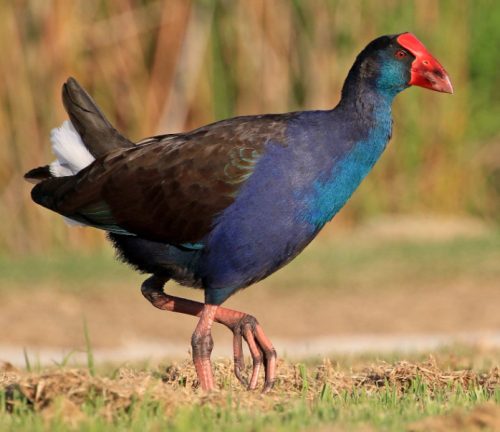
Porphyrio melanotus, the scientific name for the Australasian Swamphen, has a unique look that includes black wings, a long red beak, and a dark blue throat. Originating in Australia and Oceania, this species has spread to adjacent regions, such New Zealand, where local differences are present. In New Zealand, certain populations have acquired larger bodies, and some have black upperparts. But one element that unites all Australasian Swamphen varieties is the eye-catching red beak, which contributes to the species’ distinctive features.
Dusky Moorhen
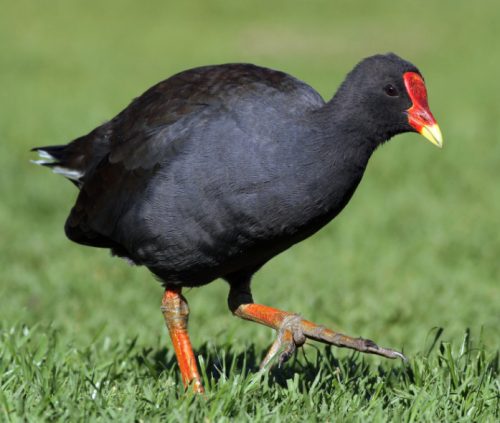
Scientifically known as Gallinula tenebrosa, the Dusky Moorhen is a dark-colored bird that is endemic to Australia and several Asian countries, including Indonesia. This ground-dwelling species is distinguished by its black and chestnut plumage and brilliant red beak, which frequently has a white tip. Within their area, these birds, which can reach a maximum size of 12 to 13 inches, hunt for seeds and insects. Their slender black tails are used for communication, and they usually dwell and travel in groups. The most important members of a group are frequently identified by their black tail flicking.
White-Throated Kingfisher
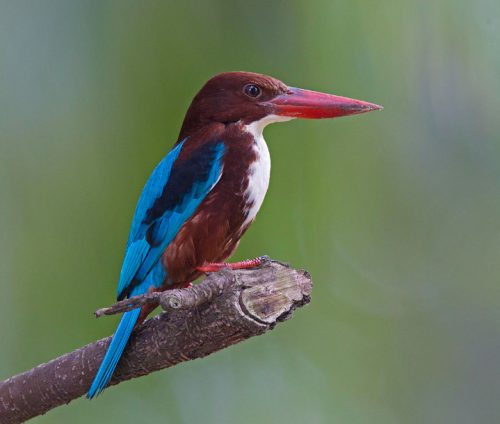
The unique white throat gives rise to the scientific name Halcyon smyrnensis, or White-Throated Kingfisher. These bright birds, with their big red beaks and blue wings, have a striking color scheme. They are typically found in coastal regions and southern portions of Asia, where they live in open grasslands and prairies at different elevations. These gregarious birds are active all day long, searching for food, which includes small fish, crabs, worms, and even mice. Even though they only migrate over short distances, they frequently modify their travel plans in response to the local monsoon season.
Rufous-Tailed Hummingbird
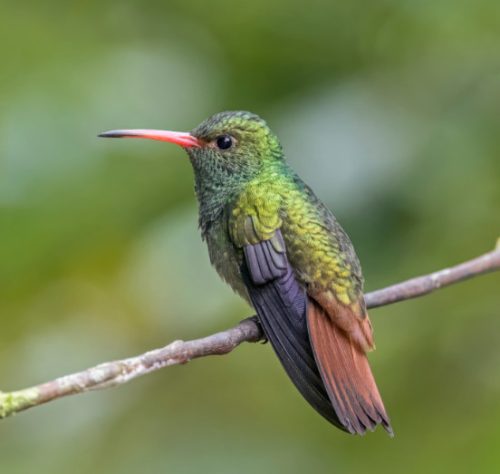
Amazilia tzacatl, the formal name for the Rufous-Tailed Hummingbird, is a bird of great diversity, with five different subspecies spread throughout northern South America and Central America. This species, which is well-known for its vivid metallic green feathers, is typified by its large red beak. Rufous-Tailed Hummingbirds migrate short distances in search of the best places to spend the winter, while being sedentary for the most part. These hummingbirds, who mostly eat insects and flower nectar, have a taste for sweet foods, which makes them a popular sight on coffee and banana plantations in Costa Rica.
Black Bulbul
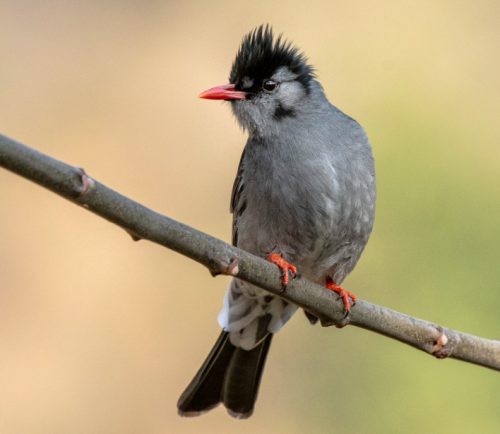
Hypsipetes leucocephalus, the formal name for the Black Bulbul, is a species of bird that is indigenous to the Asian Himalayas that thrives especially at high altitudes. Known to have at least nine subspecies, these birds show signs of partial migration, frequently lowering their altitude during the bitterly cold winter months. With a primarily black and white plumage, the Black Bulbul stands out even more due to its red beak—a characteristic shared by most subspecies. Their main food sources are insects and fruits; these birds are usually seen grazing in small groups, exhibiting cooperative behavior when searching for and eating berries, which are native to high elevations.
Brown-Hooded Kingfisher
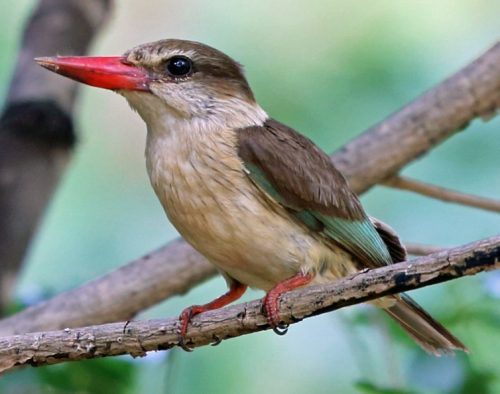
The Brown-Hooded Kingfisher, or Halcyon albiventris as it is scientifically named, is a bird that is unique to Sub-Saharan Africa; it is the only bird that lives south of the Sahara Desert. Exhibiting a remarkable red beak, this species is further recognized by its brilliant multicolored plumage ornamented with dark brown, white, chestnut, and light blue hues on its wings. With a diet that includes a wide variety of insects, arachnids, and even small scorpions and snakes, the Brown-Hooded Kingfisher is an example of a bird that can adapt. Males in particular build long-lasting relationships with females after mating, and they participate in elaborate mating rituals.
People Who Read This Also Read:

